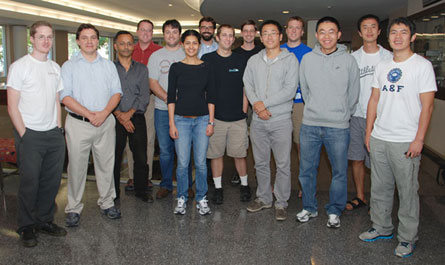Computing in Real Time

Real-Time Systems Group, from left to right: Mac Mollison, Ben Casses, Sanjoy Baruah, Jim Anderson, Bryan Ward, Bipasa Chattopadhyay, Glenn Elliott, Jeremy Erickson, Chris Kenna, Zhishan Guo, Jonathan Herman, Haohan Li, Hiroyuki Chishiro, Cong Liu.
Real-time systems are everywhere these days. Whether you’re flying in an airplane, driving a car, or checking email on your smartphone, you’re interacting in some way with real-time systems. For example, high-end modern cars often contain around 100 processors, many of which require precise timing of the operations in order to work properly.
The focus of the research of the Real-Time Systems group at UNC is on supporting real-time applications on multicore platforms. The group, led by professors Jim Anderson and Sanjoy Baruah, is currently working with the global security company Northrop Grumman Corporation on a project involving unmanned aerial vehicles. The goal of the project is to determine the viability of using multicore platforms in real-time control systems in such aircraft. The major challenge lies in devising techniques for isolating different system components so that the real-time correctness of different components can be validated independently. Certifying an aircraft design requires validating real-time correctness. This process becomes much simpler if smaller sub-systems can be analyzed independently. Two graduate students in the Real-Time Systems group, Mac Mollison and Jeremy Erickson, have held internships with Northrop Grumman, working on the unmanned aerial vehicle project.
A long-running project of the Real-Time Systems group is LITMUSRT. The name of the project stands for “Linux Testbed for Multiprocessor Scheduling in Real-Time Systems.” The project is an extension of the Linux kernel produced at UNC. The purpose of LITMUSRT is to serve as a testbed for prototyping advanced multiprocessor real-time scheduling and synchronization algorithms. It allows researchers to investigate real world limitations and the impact of overheads on system performance, which is difficult to do with just theory.
Work on LITMUSRT started in 2006, and a number of graduate students have contributed to the project over the years. Because of the work being done at UNC on LITMUSRT, the department hosted the 14th Real Time Linux Workshop here in Chapel Hill on October 18-20.
LITMUSRT is publicly available at www.litmus-rt.org. Research funding for the project comes from IBM, Intel Corporation, Northrop Grumman Corporation, NSF, the U.S. Air Force, and the U.S. Army Research Office.
